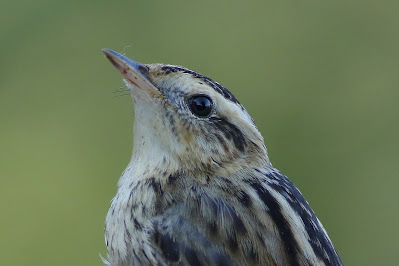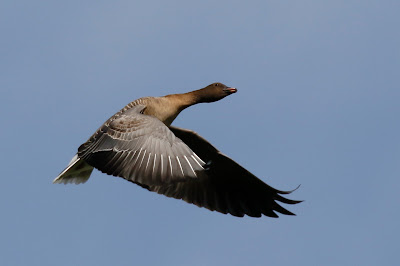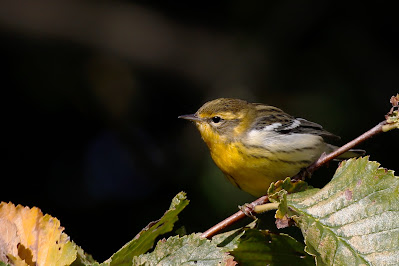Well, unless a Short-eared Owl hits the window carrying a Bittern to disturb me from my Lemsip in the next few hours, and both stay alive long enough for me to tick them, my quest to match last year's total of 224 species seen travelling under my own steam (walking and cycling) seems destined to end in failure. Grand plans to smash it this week have fallen foul of the nasty cold which has been working its way through the family. I avoided it until Boxing Day, which, being the last decent forecast of the year, had been earmarked for a long trip to the New Forest in search of a Great Grey Shrike, Hawfinch and a Red-crested Pochard at Blashford Lakes. But after a dreadful night's sleep I woke feeling sufficiently rough to conclude that a 70+mile bike ride would not have been the wisest of moves. I haven't left the house since - so nothing for it then but to relive the highlights of the year in the hope that it cheers me up a bit!
January
I started the year as I meant to go on with a 50+ mile New Year's Day flog through the rain to Dorchester to admire a lingering flock of White-fronted Geese. By contrast to last year, my strategy was to focus on quality first and quality later so I returned via Silverlake to snaffle a Goosander and then overshot home to get to Upton Country Park before dusk for the long-staying trio of Tundra Bean Geese. A successful start to the year adding three difficult species for Dorset which I was pleased to get under my belt so early in the month. I must have been in good shape as 2 days later I headed to Weymouth to see another long-stayer, an Iceland Gull, following a trawler out in the bay. Standard January fayre padded the year list but a Longham Lakes Whooper Swan (8th), a Maiden Castle Little Gull (16th) and a Lytchett Matravers Glossy Ibis (22nd) found by Paul Morton added some quality.
Bird of the month though had to wait until the 29th when I reprised my 2021 quest with Phil Saunders to see Cirl Bunting coming to seed laid on by Al Barrett and Mike Morse at West Bexington. This year a male Cirl Bunting was present which made the identification challenge somewhat easier than last year's female. This is a coveted species for me as I know the East Anglian velo-mafia who I find myself competing with will struggle to add it to their lists! The month ended with 300 miles cycled and the year list on 114, a shade down on 119 in 2021.
 |
| January photo of the month: Little Gull at Maiden Castle |
 |
| January 'green' bird of the month: Cirl Bunting at West Bexington (56 miles) |
FebruaryFebruary was the first of three months in 2022 when illness took a toll and curtailed my cycling significantly - I scraped just over 100 miles for the month adding just 15 species. While highlights were few and far between, I managed to connect with a few tricky targets including Merlin (helpfully staked out by Jol Mitchell on a local heathland), Brambling (on the Lytchett Fields feeders topped up by Ian Ballam and Shaun Robson) and one of the Dorset exotics - Ring-necked Parakeet at Studland, ticked on a lovely day when I met up with the family for a bacon roll on the beach. February also saw the first of a series of unfortunate clashes between my need to be away from home for work, and good birds being seen locally when my back was turned - I missed Bitterns leaving the local gravel pit on two different evenings as a result, failing to hear or see them on at least 6 other nights either side of these.
 |
| February photo of the month: Med Gull at Studland |
 |
| February 'green' bird of the month: Ring-necked Parakeet at Studland - the population here appears to be dwindling - perhaps the species range expansion elsewhere in southern England will save it? |
March
A couple of local scarcities (including Velvet Scoter at Arne) and the first spring arrivals were added to the yearlist in March but I wasn't pulling up any trees in the first few weeks. The 26th of the month, however, provided an opportunity for one of my most ambitious bike rides to date. It started with a 25 mile pilgrimage to Maiden Newton for Dipper - a long way but a lot closer and safer than Lyme Regis where I saw them last year, and another species the East Angles will be lucky to see. After early success I pressed on a further 11 miles to Bridport for a wintering Yellow-browed Warbler, returning via Portland Harbour where a Red-necked Grebe completed a hat-trick of desirable species. That one 78 mile trip almost doubled my mileage for the month, during which 14 additional species brought the year list to 143, slightly ahead of my 2021 tally at the same stage last year.
 |
| March photo of the month: one of the long-staying Tundra Bean Geese which first arrived at Upton in December 2021 and later relocated to my local patch at Swineham where this picture was taken |
 |
March 'green' bird of the month: Yellow-browed Warbler, Bridport (78 miles)
|
April
April brought high hopes after a string of local rarities had boosted my yearlist in 2021 but 2022 didn't quite match up, partly because we spent two weeks of it on a family holiday in Scotland. That said, I managed to add a Lytchett Fields Green-winged Teal to the yearlist thanks to Ian Ballam's excellent tide-forecasting. April also saw my first visit of the year by bike to Portland, where I connected with Ring Ouzel, a species which eluded me in 2021, as well as a Little Owl and the low hanging fruit which a short seawatch can be expected to produce: Manx Shearwater, Great and Arctic Skua. A local Mandarin Duck at the end of the month added a dash of colour and took me just shy of 200 miles cycled in April. A teensy regret was panicking and driving the 4 miles to Corfe Castle for a Black Kite found by Nick Hopper, which I assumed wouldn't hang around long enough for me to get there by bike but did!
 |
| April photo of the month: Peregrine at St Aldhelm's Head |
 |
| April 'green' bird of the month: Green-winged Teal, Lytchett Fields |
May
Spring migration seemed later this year so there was plenty to appreciate in early May and I headed to Portland for the second time this year on the 2nd to add Little Tern and various common migrants to the list. I was back again on the 8th for a Woodchat Shrike, viewed from almost exactly the same spot where a Red-backed Shrike appeared a year earlier. Things slowed down in the second half of the month and my run of bad luck when away from home continued with Red-necked Phalarope, Rose-coloured Starling and Alpine Swift all appearing within cycling distance of home whilst I was working in Reading. Fortunately the Swift hung around long enough for me to catch it up with it early on its final morning before it flew high out to sea. I cycled 342 miles in May - my second highest total for a month in 2022 - for a reward of a further 16 species added to the yearlist.
 |
| Photo of the month: Little Tern on a grey day at Ferrybridge |
 |
| May 'green' bird of the month: Alpine Swift, Ballard Down |
June
June was a bit of a disaster for the year list as the first week was earmarked for a family holiday in Norway, depriving me of the opportunity to dash to Weymouth for a Gull-billed Tern which could have been bike-bird of the year! Contracting Covid on the way home from the holiday wiped out the best part of the following fortnight and in what was left of the month I added a paltry two species (Golden Pheasant and Honey Buzzard) to the stuttering list, ending the month on 187, well below the par figure of 192 which I had reached at the same stage in 2021.
 |
| June photo of the month: Barn Owl hunting at a local site |
 |
| June's 'green' bird of the month: Honey Buzzard |
July
I resolved to get back on track after the disappointments of June and clocked up another 300+ miles for the month as a result. This effort perhaps deserved more reward than the 6 species added though it was a clear case of quality over quantity as the birds added this month included Caspian Tern (seen with Charles Stubbs at the second attempt, another bird which turned up when work took me to Reading), Lesser Yellowlegs (my first trip across the Hampshire border of 2022), Balearic Shearwater (requiring my third trip of the year to Portland) and Quail (heard at the second attempt at Tarrant Rushton, the most northerly point I reached by bike this year).
 |
| July photo of the month: Corn Bunting, Tarrant Rushton (where Quail was heard) |
 |
| July 'green' bird of the month: Caspian Tern, Stanpit (69 miles) |
August
With no big family holiday planned and a week's holiday booked mid-month, August offered an opportunity to push myself and bring an attempt to break last year's record back within sight. I made a supreme effort clocking over 370 miles for the month including three trips over the Hampshire border (for Black Tern, White-winged Tern and a Pectoral Sandpiper). Other highlights included a Friday night twitch for a White-rumped Sandpiper at Ferrybridge and 'in-the-hand' Aquatic and Grasshopper Warblers at Lytchett Bay courtesy of Shaun Robson. My man in the east Olly Frampton provided directions and Dave Bishop had the White-winged Tern pinned down for me when I arrived, whilst Julian Thomas did likewise with the White-rumped Sand. For the first time in a while I found myself ahead of par compared to 2021, with the yearlist on 205 by the end of the month compared to 202 the previous year.
 |
| August photo of the month: Spotted Flycatcher, Middlebere |
 |
August 'green' bird of the month: Aquatic Warbler, Lytchett Fields (also a Dorset tick)
|
SeptemberI was determined to press home the advantage built up relative to my 2021 tally and figured that September 2022 could not be much worse than September 2021, a month during which I added a measly 2 species to the yearlist. I matched this total on 10th alone, finding a calling Bee-eater heading over as a I twitched a Wryneck found by James Leaver which Steve Smith managed to pick up in flight. A Red-necked Phalarope near Abbotsbury the following day clawed back a desirable species which I had missed earlier in the year due to work commitments. A mid-week dash to Lodmoor added a Citrine Wagtail found by Brett Spencer to the non-motorised life list as well as the year list, whilst my fourth and final visit of 2022 to Portland enabled me to connect with Rose-coloured Starling and a bonus Red-backed Shrike, again found by Brett Spencer, on the way home. A total of 211 by the month's end compared to 204 in 2021, and was just reward for 222 miles cycled. Surely this made it odds-on I would exceed my own record?
.JPG) |
| September photo of the month: Wheatear at Durlston |
 |
| September 'green' bird of the month: Citrine Wagtail, Lodmoor (also a Dorset tick) |
October
The first half of the month saw me indulging in some 'brown birding' with jolly group trips to Shetland for a week's birding holiday and Scilly for a Blackburnian Warbler. Penance was paid in the form of a 70 mile marathon to West Bay for a Barred Warbler. A patch Barnacle Goose and a St Aldhelm's Head Pallas's Warbler found by Phil Saunders - seen at the second attempt on the same stormy day - were the only other additions to the yearlist which ended the month on 214, still 5 ahead of the same date in 2021.
 |
| October photo of the month: a late Hobby at Swineham |
 |
| October 'green' bird of the month: Barred Warbler, West Bay (70 miles) |
November
After the distractions and temptations of October, I re-committed to non-motorised birding in November, though the dark nights drawing in limited the opportunities somewhat. Those which did arise were hard work with a run of storms bringing Arctic Tern and Sabine's Gull within reach in Weymouth and Chesil Cove respectively. Dusky Warbler (pinned down for me by Garry Hayman and James Leaver) and Snow Bunting (to which I was directed by David Foster and Rich Andrews) were a bit closer to home on the Purbeck coast, and helped bring the tally for the year to 219, still 4 ahead of the 2021 equivalent of 215, a reasonable return for 229 miles cycled.
 |
| November photo of the month: Snow Bunting at Studland |
 |
| November 'green' bird of the month: Dusky Warbler, Durlston |
DecemberI had a very productive December in 2021, adding 9 species to the yearlist - but 5 of these were already on my 2022 yearlist when the month began so I knew it would be a challenge to replicate this in 2022. Still, with a bit of luck and effort the total of 224 should be within reach. Jack Snipe, located by Trevor Warwick a short walk from home, was belatedly added after much fruitless searching around local patches. My fifth and final trip to Hampshire by bike in 2022 was rewarded with good views of American Wigeon, a quality bike tick. And while Woodcock finally gave itself up in the fading light of Christmas Eve, unfortunately it was to be the last addition of 2022. 121 miles was the modest mileage for the final month of the year, and, as explained the start of this post, illness foiled my hopes of one last push between Christmas and the New Year. The total for the year ended up being 222 species, just two short of last year's figure.
 |
| December photo of the month: Great White Egret on a frozen Wareham Common |
 |
| December 'green' bird of the month: American Wigeon, Pennington (69 miles) |
So while the year ends with a bit of disappointment and a few regrets - as well as SEO and Bittern, which still haven't hit the window at time of writing, I also missed Redpoll, Long-tailed Duck, Hawfinch and Lesser Spotted Woodpecker, all of which made the list in 2021 - it's been therapeutic reliving the highlights of the wonderful birds I saw and the places they took me. The 2,600 miles cycled in pursuit of the 222 species I saw this year kept me reasonably fit and I added 15 species to my non-motorised life list, passing the landmark of 250 species seen travelling under my own steam in the process. If you tot up your own equivalent and it's anywhere close to that without you living/working at a bird observatory or the like, you're doing ok!
If you were instrumental in finding any of the birds I enjoyed seeing in 2022 or otherwise helped me on my travels, my sincere thanks; if you were neglected whilst I pursued them, my apologies. As for 2023, I think I've established 220 species by non-motorised means is about 'par' for these parts, so while I'm not sure I'll go all out to break my own record of 224 again, I'll certainly be back on the bike for pretty much all my Dorset birding (plus the bits of Hampshire I can reach if the knees hold out). Until then, have a Happy New Year and thanks for reading!
 |
| Purple Sandpiper, Sandbanks, January 2022 |
















.JPG)


















































































